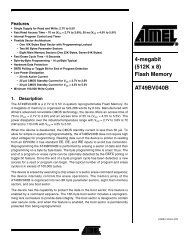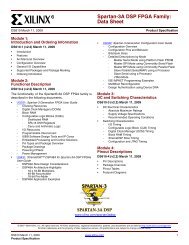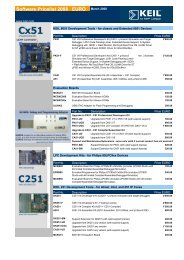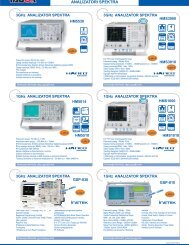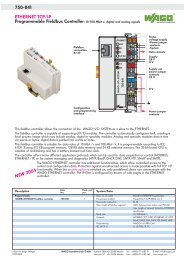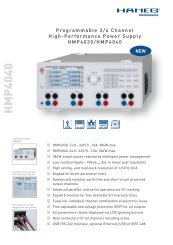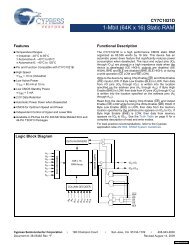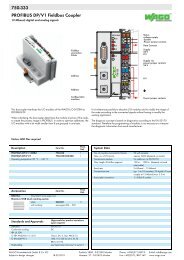PIC12F683 Data Sheet - Microchip
PIC12F683 Data Sheet - Microchip
PIC12F683 Data Sheet - Microchip
Create successful ePaper yourself
Turn your PDF publications into a flip-book with our unique Google optimized e-Paper software.
<strong>PIC12F683</strong><br />
3.6 Clock Switching<br />
The system clock source can be switched between<br />
external and internal clock sources via software using<br />
the System Clock Select (SCS) bit of the OSCCON<br />
register.<br />
3.6.1 SYSTEM CLOCK SELECT (SCS) BIT<br />
The System Clock Select (SCS) bit of the OSCCON<br />
register selects the system clock source that is used for<br />
the CPU and peripherals.<br />
• When the SCS bit of the OSCCON register = 0,<br />
the system clock source is determined by<br />
configuration of the FOSC bits in the<br />
Configuration Word register (CONFIG).<br />
• When the SCS bit of the OSCCON register = 1,<br />
the system clock source is chosen by the internal<br />
oscillator frequency selected by the IRCF<br />
bits of the OSCCON register. After a Reset, the<br />
SCS bit of the OSCCON register is always<br />
cleared.<br />
Note: Any automatic clock switch, which may<br />
occur from Two-Speed Start-up or Fail-Safe<br />
Clock Monitor, does not update the SCS bit<br />
of the OSCCON register. The user can<br />
monitor the OSTS bit of the OSCCON<br />
register to determine the current system<br />
clock source.<br />
3.6.2 OSCILLATOR START-UP TIME-OUT<br />
STATUS (OSTS) BIT<br />
The Oscillator Start-up Time-out Status (OSTS) bit of<br />
the OSCCON register indicates whether the system<br />
clock is running from the external clock source, as<br />
defined by the FOSC bits in the Configuration<br />
Word register (CONFIG), or from the internal clock<br />
source. In particular, OSTS indicates that the Oscillator<br />
Start-up Timer (OST) has timed out for LP, XT or HS<br />
modes.<br />
3.7 Two-Speed Clock Start-up Mode<br />
Two-Speed Start-up mode provides additional power<br />
savings by minimizing the latency between external<br />
oscillator start-up and code execution. In applications<br />
that make heavy use of the Sleep mode, Two-Speed<br />
Start-up will remove the external oscillator start-up<br />
time from the time spent awake and can reduce the<br />
overall power consumption of the device.<br />
This mode allows the application to wake-up from<br />
Sleep, perform a few instructions using the INTOSC<br />
as the clock source and go back to Sleep without<br />
waiting for the primary oscillator to become stable.<br />
Note:<br />
Executing a SLEEP instruction will abort<br />
the oscillator start-up time and will cause<br />
the OSTS bit of the OSCCON register to<br />
remain clear.<br />
When the Oscillator module is configured for LP, XT or<br />
HS modes, the Oscillator Start-up Timer (OST) is<br />
enabled (see Section 3.4.1 “Oscillator Start-up Timer<br />
(OST)”). The OST will suspend program execution until<br />
1024 oscillations are counted. Two-Speed Start-up<br />
mode minimizes the delay in code execution by<br />
operating from the internal oscillator as the OST is<br />
counting. When the OST count reaches 1024 and the<br />
OSTS bit of the OSCCON register is set, program<br />
execution switches to the external oscillator.<br />
3.7.1 TWO-SPEED START-UP MODE<br />
CONFIGURATION<br />
Two-Speed Start-up mode is configured by the<br />
following settings:<br />
• IESO (of the Configuration Word register) = 1;<br />
Internal/External Switchover bit (Two-Speed<br />
Start-up mode enabled).<br />
• SCS (of the OSCCON register) = 0.<br />
• FOSC bits in the Configuration Word<br />
register (CONFIG) configured for LP, XT or HS<br />
mode.<br />
Two-Speed Start-up mode is entered after:<br />
• Power-on Reset (POR) and, if enabled, after<br />
Power-up Timer (PWRT) has expired, or<br />
• Wake-up from Sleep.<br />
If the external clock oscillator is configured to be<br />
anything other than LP, XT or HS mode, then<br />
Two-Speed Start-up is disabled. This is because the<br />
external clock oscillator does not require any<br />
stabilization time after POR or an exit from Sleep.<br />
3.7.2 TWO-SPEED START-UP<br />
SEQUENCE<br />
1. Wake-up from Power-on Reset or Sleep.<br />
2. Instructions begin execution by the internal<br />
oscillator at the frequency set in the IRCF<br />
bits of the OSCCON register.<br />
3. OST enabled to count 1024 clock cycles.<br />
4. OST timed out, wait for falling edge of the<br />
internal oscillator.<br />
5. OSTS is set.<br />
6. System clock held low until the next falling edge<br />
of new clock (LP, XT or HS mode).<br />
7. System clock is switched to external clock<br />
source.<br />
© 2007 <strong>Microchip</strong> Technology Inc. DS41211D-page 27



